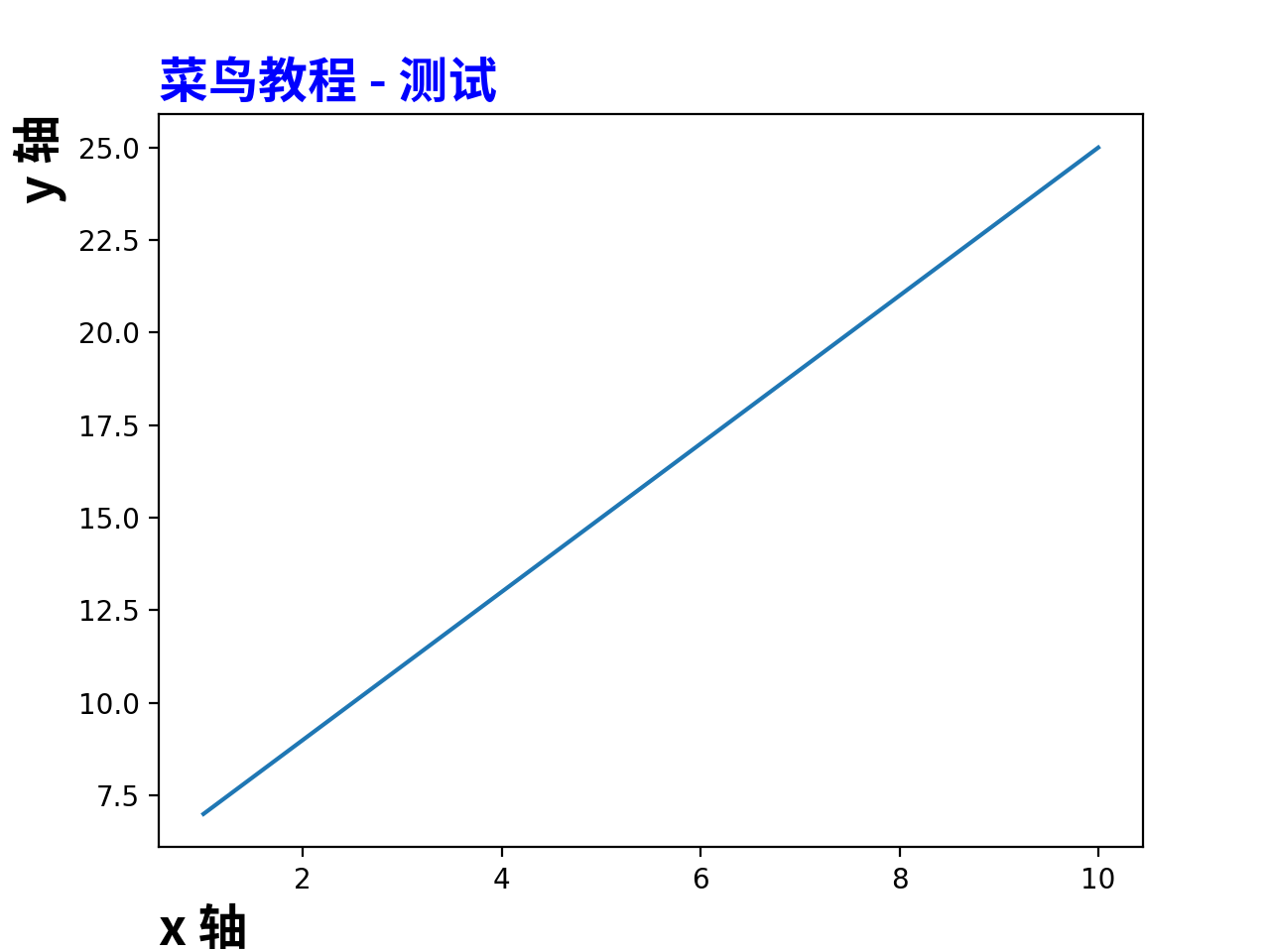x
=
np.
array
(
[
1
,
2
,
3
,
4
]
)
y
=
np.
array
(
[
1
,
4
,
9
,
16
]
)
plt.
plot
(
x
,
y
)
plt.
xlabel
(
"x - label"
)
plt.
ylabel
(
"y - label"
)
plt.
show
(
)
显示结果如下:
我们可以使用
title()
方法来设置标题。
import
numpy
as
np
import
matplotlib.
pyplot
as
plt
x
=
np.
array
(
[
1
,
2
,
3
,
4
]
)
y
=
np.
array
(
[
1
,
4
,
9
,
16
]
)
plt.
plot
(
x
,
y
)
plt.
title
(
"RUNOOB TEST TITLE"
)
plt.
xlabel
(
"x - label"
)
plt.
ylabel
(
"y - label"
)
plt.
show
(
)
显示结果如下:
图形中文显示
Matplotlib 默认情况不支持中文,我们可以使用以下简单的方法来解决。
这里我们使用思源黑体,思源黑体是 Adobe 与 Google 推出的一款开源字体。
官网:
https://source.typekit.com/source-han-serif/cn/
GitHub 地址:
https://github.com/adobe-fonts/source-han-sans/tree/release/OTF/SimplifiedChinese
打开链接后,在里面选一个就好了:
你也可以在网盘下载:
https://pan.baidu.com/s/10-w1JbXZSnx3Tm6uGpPGOw
,提取码:
yxqu
。
可以下载个 OTF 字体,比如 SourceHanSansSC-Bold.otf,将该文件文件放在当前执行的代码文件中:
SourceHanSansSC-Bold.otf 文件放在当前执行的代码文件中:
import
numpy
as
np
from
matplotlib
import
pyplot
as
plt
import
matplotlib
zhfont1
=
matplotlib
.
font_manager
.
FontProperties
(
fname
=
"
SourceHanSansSC-Bold.otf
"
)
x
=
np
.
arange
(
1
,
11
)
y
=
2
*
x
+
5
plt
.
title
(
"
菜鸟教程 - 测试
"
,
fontproperties
=
zhfont1
)
plt
.
xlabel
(
"
x 轴
"
,
fontproperties
=
zhfont1
)
plt
.
ylabel
(
"
y 轴
"
,
fontproperties
=
zhfont1
)
plt
.
plot
(
x
,
y
)
plt
.
show
(
)
执行输出结果如下图:
from matplotlib import pyplot as plt
import matplotlib
a=sorted([f.name for f in matplotlib.font_manager.fontManager.ttflist])
for i in a:
print(i)
打印出你的 font_manager 的 ttflist 中所有注册的名字,找一个看中文字体例如:STFangsong(仿宋),然后添加以下代码即可:
plt.rcParams['font.family']=['STFangsong']
此外我们还可以自定义字体的样式:
import
numpy
as
np
from
matplotlib
import
pyplot
as
plt
import
matplotlib
# fname 为 你下载的字体库路径,注意 SourceHanSansSC-Bold.otf 字体的路径,size 参数设置字体大小
zhfont1
=
matplotlib.
font_manager
.
FontProperties
(
fname
=
"SourceHanSansSC-Bold.otf"
,
size
=
18
)
font1
=
{
'color'
:
'blue'
,
'size'
:
20
}
font2
=
{
'color'
:
'darkred'
,
'size'
:
15
}
x
=
np.
arange
(
1
,
11
)
y
=
2
* x +
5
# fontdict 可以使用 css 来设置字体样式
plt.
title
(
"菜鸟教程 - 测试"
,
fontproperties
=
zhfont1
,
fontdict
=
font1
)
# fontproperties 设置中文显示,fontsize 设置字体大小
plt.
xlabel
(
"x 轴"
,
fontproperties
=
zhfont1
)
plt.
ylabel
(
"y 轴"
,
fontproperties
=
zhfont1
)
plt.
plot
(
x
,
y
)
plt.
show
(
)
输出结果如下:
标题与标签的定位
title()
方法提供了
loc
参数来设置标题显示的位置,可以设置为:
'left', 'right', 和 'center', 默认值为 'center'
。
xlabel()
方法提供了
loc
参数来设置 x 轴显示的位置,可以设置为:
'left', 'right', 和 'center', 默认值为 'center'
。
ylabel()
方法提供了
loc
参数来设置 y 轴显示的位置,可以设置为:
'bottom', 'top', 和 'center', 默认值为 'center'
。
import
numpy
as
np
from
matplotlib
import
pyplot
as
plt
import
matplotlib
# fname 为 你下载的字体库路径,注意 SourceHanSansSC-Bold.otf 字体的路径,size 参数设置字体大小
zhfont1
=
matplotlib.
font_manager
.
FontProperties
(
fname
=
"SourceHanSansSC-Bold.otf"
,
size
=
18
)
font1
=
{
'color'
:
'blue'
,
'size'
:
20
}
font2
=
{
'color'
:
'darkred'
,
'size'
:
15
}
x
=
np.
arange
(
1
,
11
)
y
=
2
* x +
5
# fontdict 可以使用 css 来设置字体样式
plt.
title
(
"菜鸟教程 - 测试"
,
fontproperties
=
zhfont1
,
fontdict
=
font1
,
loc
=
"left"
)
# fontproperties 设置中文显示,fontsize 设置字体大小
plt.
xlabel
(
"x 轴"
,
fontproperties
=
zhfont1
,
loc
=
"left"
)
plt.
ylabel
(
"y 轴"
,
fontproperties
=
zhfont1
,
loc
=
"top"
)
plt.
plot
(
x
,
y
)
plt.
show
(
)
输出结果如下:


